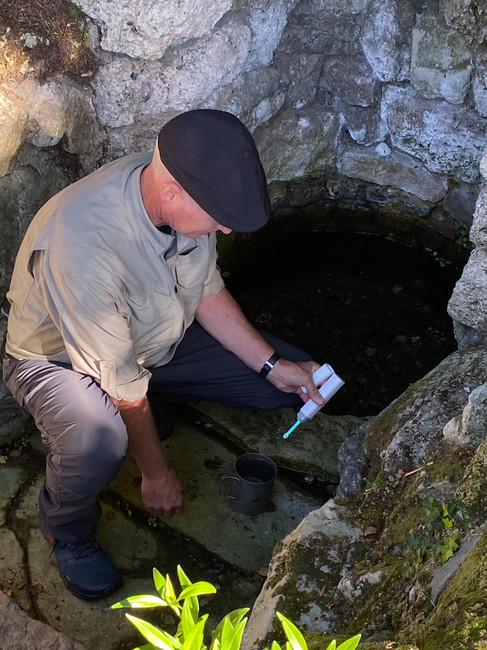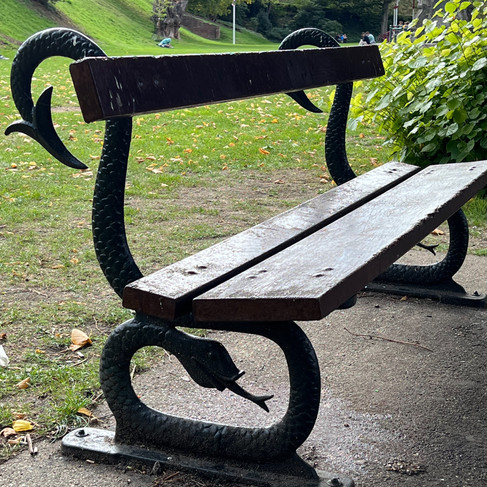Canterbury Continued | September 19, 2022
- Fredericksburg Pilgrims
- Oct 11, 2022
- 7 min read
Updated: Oct 12, 2022
Today was a “stay-in-place” day, and we were so excited to explore Canterbury and the surrounding environs! We walked to St. Thomas of Canterbury Catholic Church for 7:30 am Mass, and then afterwards, the priest, Fr. John, invited us to the rectory for our pilgrim passport stamps. There we also met with Canon Father Anthony (who we met the day before) and had a pleasant conversation with both of them. We talked about pilgrimage and our experiences, and we gave both of them a chaplet, which they much appreciated.
(1) Left: Ready for Mass at St. Thomas of Canterbury Catholic Church. (2) Right: With Fr. John and Fr. Anthony.
After a quick breakfast at Caffe Nero, our first stop of the day was St. Dunstan Church, where we received a Pilgrim sticker rather than a stamp. The most important relic in this 11th century church is the severed head of St. Thomas More, which is buried in the floor of the church's Roper Chapel. Thomas More was a lawyer, philosopher, author and statesman who served King Henry VIII as Lord Chancellor and Speaker of the House of Commons. He was one of the few leading men in England who opposed Henry VIII’s divorce from Catherine of Aragon.
When Thomas refused to take the Oath of Succession, which repudiated papal authority, he was found guilty of high treason and beheaded on July 6, 1535, the eve of the translation of the body of Thomas Becket from the crypt to the Trinity Chapel in Canterbury Cathedral. Thomas More’s head was displayed on a pike on London Bridge as a warning to traitors, but his daughter, Margaret Roper, managed to retrieve it, and it was subsequently kept in the Roper family vault. The vault is now buried beneath the floor of the St. Nicholas Chantry Chapel in St. Dunstan Church.
(1) Left: Exterior of St. Dunstan Church, Canterbury. (2) Right: Inside St. Dunstan's.

Brilliant stained glass window. Left: St. Dunstan, Archbishop of Canterbury, 959-988. Center: St. Thomas More, Lord Chancellor under King Henry VIII, 1529-1532. Right: St. Lanfranc, Archbishop of Canterbury, 1070-1089.
(1) Left: Sign pointing the way to the Roper Chapel. The quote “(I die) the King’s good servant, but God’s first” are the words St. Thomas said to the crowd before he was beheaded. (2) Right: Stone plaque marking the Roper family vault. The Latin inscription honors More's death for religious liberty: "That the English Church might be free." More was canonized in the Roman Catholic church in 1935 and added to the Anglican calendar of saints in 1980.
Below is the Thomas More Window. This beautiful stained-glass window depicts scenes from the life of St. Thomas More, and it overlooks the altar in the Roper Chapel. It was made in 1973 by Lawrence Lee, one of the foremost English glaziers.
This link offers additional information about who is depicted in each panel of the window. You can click on each window panel for detailed information.

An interesting note: One of the contributors to the purchase of the window was St. Thomas More Roman Catholic Church in Kansas City, MO.

By the time we finished visiting St. Dunstan's, the streets in Canterbury were rather empty, as all of England was preparing for the funeral of Queen Elizabeth II. Many shops and venues were closed, and so we decided to retrace our steps from the day before by walking into Harbledown and visiting St. Michael and All Angels Church (closed) and St. Nicholas “Hospital” Church and Almshouse (also closed).
St. Nicholas Hospital was founded in 1084 by Archbishop of Canterbury Lanfranc as a hospital for lepers. With the disappearance of leprosy from England, it gradually turned into an almshouse, and now it provides sheltered housing for the elderly. When Henry II came to do public penance for St. Thomas Becket’s murder, he walked to Canterbury Cathedral from Harbledown. As an additional penance, Henry granted 20 marks to be paid annually to St. Nicholas Hospital.
(1) Left: St. Nicholas Church, Harbledown. (3) Right: The almshouse at St Nicholas.
We searched for and found the Black Prince’s Well (aka St. Thomas Well) which has slaked pilgrims' thirst for centuries and is believed to have the power to cure various ailments. The Black Prince was Edward of Woodstock, Prince of Wales, the eldest son of King Edward III, who is said to have visited the well twice. It is not known why exactly he was called “The Black Prince”, but perhaps it was a reference to his black armor and shield.

The Black Prince's Well.
Frans points to three carved feathers, the insignia of the Princes of Wales.
Frans had carried dedicated water purification equipment with him in his pack in order to safely (?!) drink water from this well. After straining a cup full of spring water through a micropore filter and using a UV pen to sterilize it not once, but three times, he downed a large gulp. Delicious! There were, alas, no other of his pilgrim compatriots willing to drink this saintly healing elixir!
Sterilizing and drinking the water!
Walking back towards Canterbury, we passed through the 60-foot-high Westgate, the last surviving of Canterbury’s seven medieval gates and the largest surviving city gate in England. Built around 1380 of Kentish ragstone (a hard grey limestone), the Westgate was consistently the most important of the city's gates, as it is the entrance to the London Road and the main entry point from most of Kent. A gate existed here at the time of the Norman conquest, and it is thought to have been a Roman structure. The present towers are the medieval replacement of the old Roman west gate, and the road still passes between the drum towers.
(1) Left: Full view of the Westgate. (2) Right: Walking through the Westgate.
Passing through the towers, we came to the intersection of High Street and Best Lane and saw the dramatic, larger-than-life bronze sculpture of Geoffrey Chaucer, sculpted by Kent-based artist Sam Holland. Unveiled in 2016 and the result of a ten-year project led by the Canterbury Commemoration Society, the statue depicts Chaucer dressed as a Canterbury pilgrim. He faces Eastbridge Hospital, where many pilgrims spent the night before heading to the cathedral. In his right hand, he holds a manuscript of the opening text of the Canterbury Tales, and at his feet are the printer’s blocks for his name, reminding us that the Canterbury Tales was one of the first printed books.

Chaucer stands on a large plinth, sculpted in bas-relief by Yorkshire-based artist Lynn O'Dowd. Taking the form of a horse’s hoof, the plinth shows images of the thirty characters that appear in the Canterbury Tales. If you look closely at the plinth, you can see Chanticleer, the rooster mentioned in the Nun’s Priest’s Tale.
We continued onward and then came to the end point of our pilgrimage--Canterbury Cathedral! What a glorious house of worship!
Canterbury Cathedral.
Close-ups of the exterior of the transept (left) and the entrance (right).
The gatekeeper at the cathedral recognized us as pilgrims and stamped our pilgrim passports. The cathedral was only open for prayer, not for touring, so we went inside and prayed during the 12-noon time of the national moment of silence for the Queen.

Dramatic interior of the cathedral.
We were meant to have a Pilgrim Blessing at the cathedral in the afternoon, but due to the Queen’s funeral today, we rescheduled it for tomorrow. Outside the cathedral, we met a nice Cathedral Constabulary Guard who showed us the starting stone marker for the Via Francigena, the pilgrimage walking route from Canterbury to Rome. What an inspiration! – maybe next year?
(1) Left: Flower memorials for Queen Elizabeth left outside the cathedral. (2) Right: Starting point marker for the Via Francigena.
From the cathedral we walked beyond the city center toward Augustine Abbey (locked for the Queen’s funeral) and St. Martin Church (also locked), the oldest parish church still in regular use for worship in England, dating back to at least the 6th century.

Outside St. Martin's Church, Canterbury.

This sketch shows the time periods during which parts of St. Martin's were built.
After a stop at Bill’s Restaurant for lunch, we walked to Dane John Park, Canterbury's largest and most popular public park. The intriguing name comes from the Norman French 'donjon’, meaning the main tower, or keep, of a fortification (forerunner of our word 'dungeon').

The main structure in the gardens is the Dane John mound, where a motte-and-bailey castle was built in the 11th century. William the Conqueror established this castle (as well as others at Dover and Rochester), a simple wooden structure atop a high mound, or motte, surrounded by a walled courtyard called a bailey. Hence these types of fortifications are called “motte-and-bailey”. The mound itself existed well before the Norman Conquest; it dates to at least the 1st century AD and was probably a former Roman cemetery.
Today, however, the keep at the top of the mound no longer exists. Instead, there is a monument commemorating Alderman James Simmons' gift of the gardens to the people of Canterbury.

Leslie walks down the hill after viewing the mound and monument.
(1) Left: Walkway in Dane John gardens. (2) Right: Interesting serpent bench in the park.
The city walls border one side of the gardens:
From left: (1,2) City wall enclosure with tower. Note the arrow loop on the tower. (3) Close-up of the arrow loop.
We walked to the top of the mound and had an excellent view of the city.

View of Canterbury Cathedral from the top of the mound.
Our final stop of the day was visiting the ruins of Canterbury Castle. Begun around 1070 by William the Conqueror, the castle replaced the earlier motte-and-bailey built at Dane John to guard the Roman road from Dover to London. The great stone keep was constructed during the reign of King Henry I (1100-1135). We could not enter the property, as the ruins of the castle were fenced off due to unsafe conditions of falling rocks from the facade of the castle.

The ruins of Canterbury Castle.
We ended our day with dinner at the Corner House Restaurant and were surprised to discover that our travels for our “day off” actually encompassed ten miles! We discussed the days events and agreed that our greatest joy was meeting with the priests at St. Thomas, visiting St. Dunstan's Church, and absorbing the quiet atmosphere of prayer at Canterbury Cathedral. We are looking forward to tomorrow, when we will visit the cathedral for our pilgrim blessing. But for now, we will relax after a busy and enjoyable day.
















































Comentários